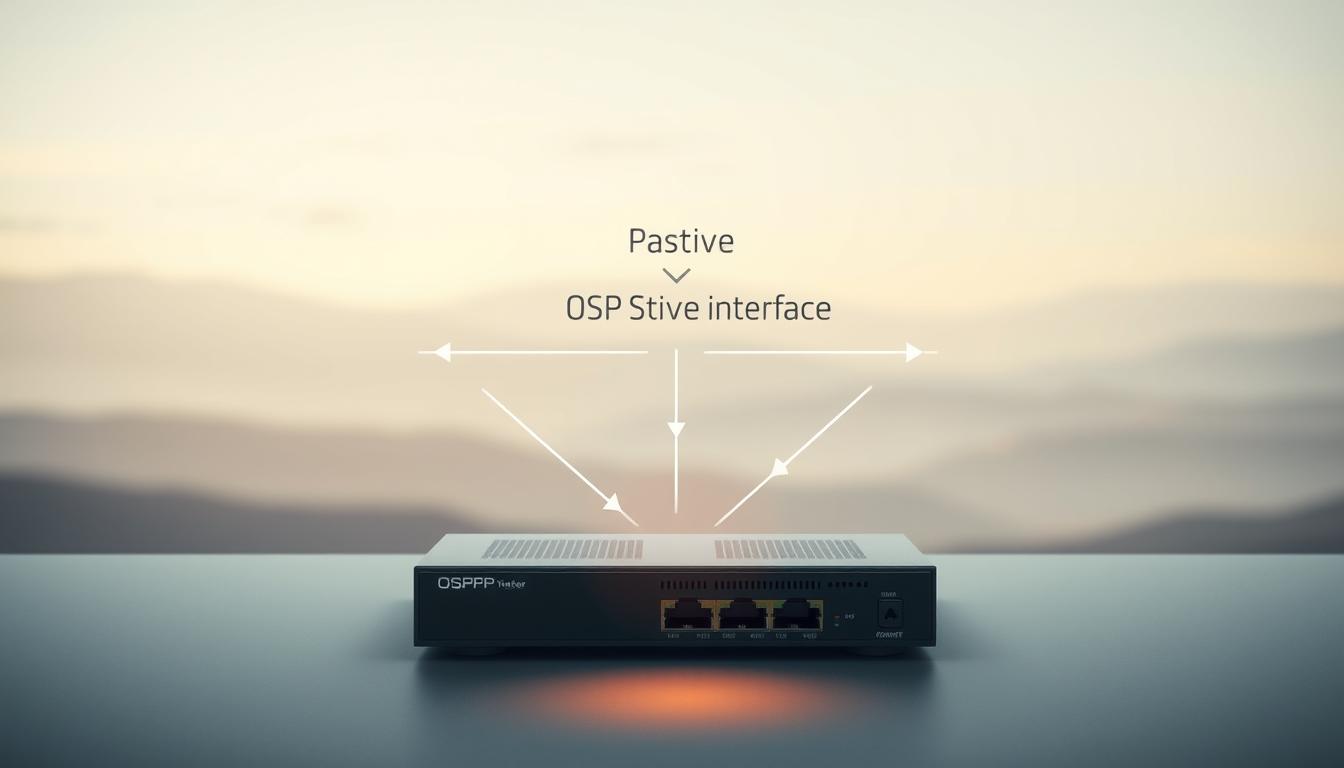Did you know many enterprise networks have hundreds of router interfaces? They need careful control over routing updates. The passive interface command is key in managing this.

The passive interface command stops outgoing routing updates on specific interfaces. It keeps networks safe from unwanted neighbors. A Cisco reference shows it can improve performance by filtering traffic. This command is simple yet powerful, helping administrators protect their networks.
Why Routing Protocols Are Essential for Network Communication
Modern networks rely on reliable routing protocols. They make sure data moves between devices smoothly. These protocols help routers share routes efficiently, making packet delivery fast and reliable.
EIGRP and OSPF show how dynamic updates are key. EIGRP’s passive interface feature cuts down on unnecessary updates. This is similar to OSPF’s approach, both aiming to improve network performance by reducing route ads and securing key connections.
Learning about passive interface OSPF settings makes networks more flexible. It allows for better control over route exchange, especially when managing multiple routing protocols. This precision helps keep networks fast and traffic flowing smoothly by reducing unnecessary updates and enhancing overall efficiency.
Understanding these technologies well means networks can adapt easily. Using proven methods, networks stay up and running with little downtime. This ensures data stays safe and reliable on many platforms.
Understanding passive interface command
Networks work best when they route efficiently. This method helps cut down on unnecessary traffic. It’s a key tool for stopping unwanted route exchanges on specific interfaces.
Many network admins use it to block unwanted connections. This keeps sensitive areas safe from harm.
Defining the Purpose and Function
The passive-interface command stops routers from sending updates on certain ports. This lets admins control where updates go.
- Eliminates unneeded updates on certain interfaces
- Reduces overhead across OSPF or EIGRP links
- Prevents undesired routing adjacencies
Default Passive Interfaces stop routers from forming adjacencies in areas that don’t need dynamic routing. This saves resources and makes network management easier.
How It Relates to Routing Protocol Behavior
Routing protocols need stable routes and consistent neighbor relationships. The passive-interface command limits link-state packets. This reduces unnecessary chatter, making EIGRP and RIP smoother.
It also keeps local endpoints safe from external scans. For more insight into how routers communicate and establish relationships, explore this guide on OSPF neighbor states.
What Does the Passive Interface Command Do in Cisco Networking?
Passive interface acts as a protective layer that silences specific interfaces. This ensures only essential updates flow across the network. Administrators often choose interfaces that don’t need dynamic routing to cut down on chatter and security risks.
By narrowing the scope of neighbor adjacencies, the impact on network resources stays controlled.
Key Advantages for Network Stability
Turning on passive interface keeps unnecessary exchanges off shared links. This reduces random traffic spikes and mitigates risks from malicious interference. Network performance stays consistent, and fewer updates reach irrelevant segments.
Stability improves, which is key in environments with numerous interfaces. Controlling overhead is essential here.
When to Consider It for Your Setup
Operators with large-scale Cisco deployments benefit from this feature. Before, silencing non-adjacent interfaces was a one-by-one process. Now, it’s simpler.
Choosing which links remain active depends on traffic patterns, security zones, and the need for dynamic routing. Passive interface is great for stub areas or local device connections. These segments rarely need full routing exchanges.
How passive interface ospf Impacts Your Routing Topology
Using passive interface ospf on certain links changes how routers share updates. Routers don’t form neighbor relationships on these ports, saving bandwidth. Subnets become stubs, so OSPF doesn’t flood them with updates.
This makes the network more efficient and secure.

Enhancing Security and Reducing Traffic
Passive interface ospf keeps sensitive links hidden. This reduces OSPF traffic, lowering the risk of leaks. It also improves network performance in big setups.
Network admins get a cleaner, more efficient routing system.
Ensuring Accurate Route Advertisements
Even with passive interfaces, routers keep active segments updated. This setup blocks unnecessary traffic and keeps routes accurate. It’s a smart choice for networks needing tight security.
For more flexible networks, consider no passive interface ospf. Each network is unique, so the choice depends on specific needs.
Exploring no passive interface ospf for Flexible Configurations
Changing an interface from passive to active keeps networks dynamic. This lets some ports make direct connections and share key updates. At first, passive-interface default might have been used to quiet all interfaces. But then, no passive interface ospf was needed for specific activation.
Reasons to Disable the Passive State
Sometimes, an interface needs to join full routing again. This is true when new neighbors must connect or data must flow through certain paths. By using no passive interface ospf, updates can go both ways. This helps devices that need live exchanges.
Common Misconfigurations to Avoid
Admins might forget to turn passive ports back on, causing routes to disappear. Others might mix up commands or not check adjacencies. Checking routing can show missing peers or incomplete tables. Keeping track of passive-interface default helps avoid mistakes when switching ports.
| Command | Purpose | Typical Use |
|---|---|---|
| passive-interface default | Silences all interfaces by default | Used to minimize routing chatter |
| no passive interface ospf | Restores active updates on selected interfaces | Applied when a port must form adjacencies |
Passive-Interface Default and Its Role in Simplifying Routing
Passive-interface default makes things easier by setting all interfaces to passive by default. This saves time and effort in big networks. It also reduces mistakes and makes your job simpler.
The Default Passive Interfaces feature is great for big networks. It works well with ospf passive settings. This keeps most interfaces quiet, only turning on the ones needed for connections.

Networks with passive-interface default have fewer route ads and less work. You can easily turn on specific interfaces without changing all of them. This leads to fewer errors and more stable routes.
- Fewer manual edits for massive topologies
- Easier isolation of critical neighbor relationships
This approach keeps things organized, which is great for teams handling many networks. It makes configuration easier and boosts reliability. ospf passive is a big plus for today’s networks.
Real-World Examples of OSPF Passive Interfaces
Many network admins use passive interfaces on stub networks or loopback interfaces. These handle router IDs. It helps avoid unnecessary OSPF adjacencies and cuts down on link-state updates in big networks.
In labs, engineers test OSPF routing with a strategy similar to EIGRP. They see how passive interfaces impact OSPF routing.
Understanding the passive-interface command is straightforward. First, find interfaces that don’t need dynamic adjacency. Then, decide to use a default passive state. Remove passivity where active routing is needed.
This method works well on Cisco devices, even in big networks.
Practical Deployment in Cisco Devices
Operators choose which interfaces need full neighbor relationships. The rest are set to passive to cut down on overhead and stray connections. Checking logs and using show commands shows a stable network.
Tips for Seamless Integration
- Mark interfaces as passive at the start of routing setup.
- Watch for adjacency changes with show ip ospf commands.
- Use this guide for tips.
| Scenario | Configuration Focus | Benefit |
|---|---|---|
| Stub Networks | passive-interface | Fewer adjacencies |
| Loopback Addresses | passive-interface set | Reduced traffic |
| Main Routers | no passive-interface | Full dynamic routing |
Common Pitfalls and How to Avoid Them
Many networking setups fail because important interfaces are not active. Administrators often forget to use no passive-interface commands. This mistake can make routers isolated and unable to find dynamic neighbors.
Turning on passive-interface default can lock down important segments unless exceptions are made. Not using no passive-interface default can leave critical paths silent. A hasty approach can lead to no discovered neighbors at all.
Overlooking Passive Status in Dynamic Protocols
Active routing needs accurate interface states. Ignoring which interfaces need updates can block important route ads. Regular checks ensure each interface is set for real-time exchange.
Misuse of passive-interface Default Commands
Using passive-interface default keeps traffic quiet but can hide problems. Switching between passive and no passive-interface needs a careful plan. Keeping an inventory of interfaces helps avoid confusion when enabling or disabling dynamic forwarding.
Best Practices for Implementing the Passive Interface Feature
Starting with a passive interface default saves time and resources in big networks. It cuts down CPU usage by reducing route processing. Yet, it keeps connections secure. Network teams often choose to enable adjacency only on interfaces that really need dynamic routing.
It’s a good idea to check your routing table with commands like show ip route, show ip protocols, and show ip interface. This makes sure you don’t accidentally leave important interfaces passive. Keeping records helps track each interface’s status, avoiding changes missed during maintenance.
Learn about EIGRP guidelines in this official reference. Good planning keeps neighbor relationships strong and cuts down on troubleshooting.
Here’s a quick list of useful commands:
| Command | Purpose | Key Tip |
|---|---|---|
| show ip route | Displays routing table | Confirm active paths |
| show ip protocols | Shows routing protocol details | Check routing sources |
| show ip interface | Shows interface status | Uncover passive settings |
Troubleshooting no passive-interface Issues
This phase can reveal hidden gaps in your routing environment. Switching from passive-interface settings to active routing on multiple interfaces may fix neighborship issues. But, mismatched network statements or incorrect passivity can block essential routes.
Identifying Misconfigurations
Misaligned commands can keep important segments isolated. A simple network review can show why certain paths fail. It’s important to observe carefully to find undetected errors.
- Review event logs for adjacency warnings
- Use show ip ospf neighbor to verify active neighbors
- Check show ip interface to confirm if an interface is passive or not
- Compare routing tables with show ip route to validate learned routes
Reliable Debugging Techniques
Running targeted commands helps avoid guesswork. Debug messages reveal dropped hellos or incomplete route ads. This gives you a clear path to solutions. Using debug ip ospf hello or debug eigrp packets helps focus on real-time updates.
| Command | Purpose |
|---|---|
| no passive-interface default | Reverts all interfaces to active, exposing possible misconfigurations |
| passive-interface | Enables passive behavior on chosen interface to limit routing updates |
Conclusion
Passive interfaces are key to better network security and performance. They help control how routing protocols share updates. This cuts down on unnecessary traffic and reduces risks from unwanted connections.
Using the cisco passive interface command is a wise move for many setups. It makes path advertisements more efficient and fights threats that target open connections.
EIGRP or OSPF work well with this feature. It’s all about limiting unnecessary connections. This makes networks more secure and cost-effective, whether for big carriers or small businesses.
A solid network design focuses on managing traffic. This ensures data moves efficiently without unnecessary chatter. Adding cisco passive interface configurations lays a strong base for future growth.
FAQ
What does the passive-interface command do in Cisco networking?
The passive-interface command stops routing protocols like OSPF, EIGRP, or RIP from sending or getting updates on certain interfaces. This cuts down on unnecessary network traffic. It also keeps the network reachable without too much overhead.
Is “ospf passive” the same as configuring a passive interface in OSPF?
Yes. It’s also called passive interface ospf. It stops OSPF from forming neighbors on certain interfaces. This makes the network safer and more efficient by reducing the number of updates.
When should I use the no passive interface ospf command?
Use no passive interface ospf on interfaces that should form neighbor relationships. This is after you’ve set passive-interface or passive-interface default globally. It lets the interface start sending and receiving routing protocol messages again.
What are the benefits of using a cisco passive interface in large enterprise networks?
Using a cisco passive interface strategy saves CPU power by not sending out unnecessary route updates. It also makes the network safer by reducing the number of interfaces that can be attacked.
How does passive-interface default streamline OSPF deployments?
A: Passive-interface default makes all interfaces passive by default. This means you don’t have to set each one individually. Then, you can make a few interfaces active with no passive-interface to form adjacencies, making router setups easier.
What does the passive interface default command do for EIGRP or RIP?
For EIGRP or RIP, passive interface default blocks these protocols from sending updates out of all interfaces. You can make specific interfaces active again with no passive-interface.
How can I verify if an interface is unintentionally passive?
Use show ip interface or show ip ospf interface to check an interface’s status. If it’s passive, it won’t have neighbors. Fix it by removing the passive state where needed.
Why is tracking passive interfaces critical for network security?
Keeping an eye on passive-interface settings helps ensure only the right interfaces share routing info. This reduces the chance of attacks and unnecessary network traffic.
Are Your Cybersecurity Essentials Covered?
Don't wait until a threat strikes to protect your organization from cybersecurity breaches. Download our free cybersecurity essentials checklist and take the first step toward securing your digital assets.
With up-to-date information and a strategic plan, you can rest assured that your cybersecurity essentials are covered.
Get the Checklist
Posted in:
Share this
